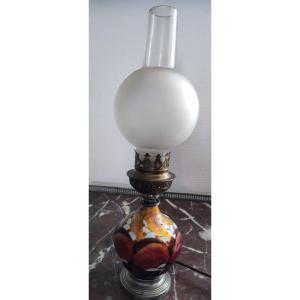"Enamel Lamp Camille Fauré XX Centuries"
"superb lamp in Limoges enamels Camille Fauré with XXth Century art deco decor" Spherical vase, in copper and Limoges enamels, signed Camille Fauré *, with rich art deco decoration in several colors, from the XXth century. This vase is in good condition and is very decorative. Signed at the bottom. * Camille Fauré (1874-1956): At the dawn of the 1920s, the production of Limoges enamels experienced a new boom in the person of Camille Fauré (1874-1956), Entrepreneur of genius, he knew how to seize the air time in his active workshops from 1920 to 1980. At the age of 21, Camille took over the activity of his late father, a house painter, and multiplied niche markets by specializing in signs, shop windows, churches or fake marble. In permanent contact with the community of enamellers in the region, he decided in 1920 to devote part of his activity to artistic enamels. He hired Alexandre Marty, an experienced enameller, pupil and son-in-law of a renowned porcelain decorator, Alfred Draft. Their work consists of offering small flamed and frosted vases, stamped "Fauré Marty Limoges". Collections developed in the tone of what has been done for a few years in Limoges. In 1924, Fauré separates from Marty wishing to change clientele. it targets a high-end clientele made up of foreign buyers, specialized stores and Parisian establishments in the Faubourg Saint-Honoré. Camille Fauré hires five highly talented enamellers. He lets his workers work at their own pace, to create exceptional pieces marked by Art Deco. Until 1930, vases with geometric and cubist decorations burst onto the art market and seduced all of Paris. This is the fashion for enamels in relief. Their creators (Louis Valade, Lucie Dadat, Pierre Bardy and others…) will remain in the shadows while manufacturing vases which remain today as the most prestigious. From 1925, he met with great success at the Lyon Fair until 1930 when he was hit by the crisis. Faced with the crisis, Fauré decided once again to reorient his production, this time turning to a mass market, producing works at low prices with floral and naturalistic decoration. At the same time, he continues to edit vases from the previous period. The activity of Camille Fauré's workshop grew until the 1960s. About twenty workers produced numerous pieces for all budgets. Camille Fauré died in 1956 and his daughter Andrée took over, with her husband Louis. If vases with geometric decoration came back into fashion in the 1960s, the workshop closed its doors in 1985, despite numerous attempts to revive it by his son Gérard. Fashion has definitely changed. (See Proantic Magazine) Dimensions Diameter approx. 8 cm Height approx. 34 cm with ball glass height without glass 18 cm



